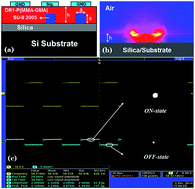Demonstration of a high-speed switch with coplanar waveguide electrodes based on electro-optic polymer-clad waveguides
Abstract
In this paper, a high-speed Mach–Zehnder interferometer type of electro-optic switch with coplanar waveguide electrodes was studied. The characteristic parameters of the switch were carefully designed and simulated. The fabrication was done by using standard semiconductor fabrication techniques such as spin-coating, photolithography, and wet etching. The device was fabricated based on electro-optic polymer-clad waveguides with the simple wet-etching procedure. The device shows a low insertion loss of about 7.3 dB. The measured switching rise time and fall time are 29.00 and 30.89 ns, respectively. This waveguide structure and the fabrication process are shown to be valuable for EO switches and modulators application.


 Please wait while we load your content...
Please wait while we load your content...